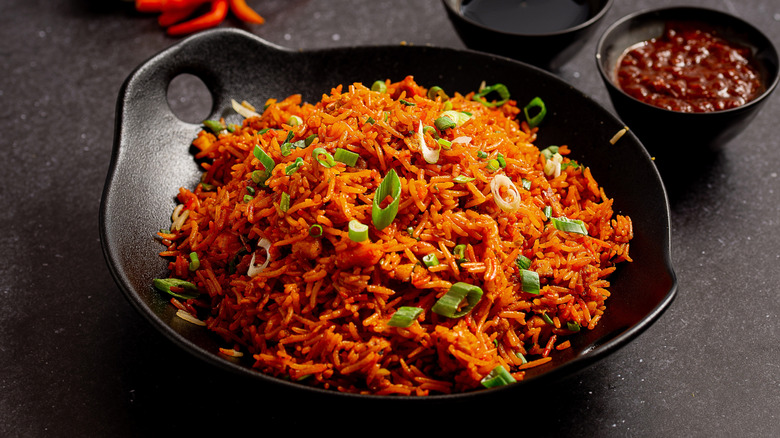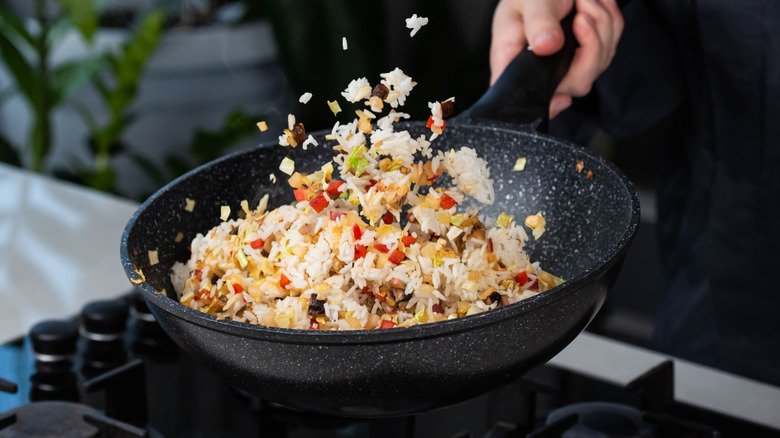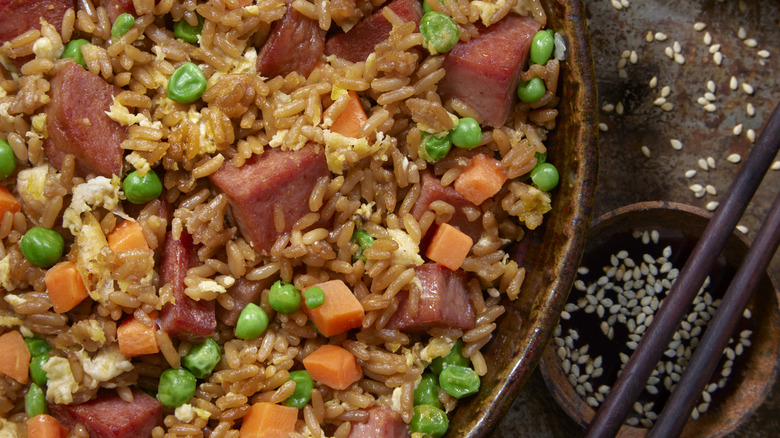Restaurant Fried Rice Always Tastes Better Than Homemade. Here's Why
Fried rice is a non-negotiable when you go out for Asian food. It's the perfect side for classics like sweet and sour chicken or char siu pork, and can stand strong on its own, especially when tossed with chicken or vegetables. At home, making fried rice seems simple enough, with rice stir-fried over high heat with your choice of aromatics, vegetables, protein, oil, and seasonings, yet somehow the results rarely match the restaurant version. To find why, Food Republic spoke exclusively with Maricel Gentile, owner of Maricel's Kitchen and author of "Maricel's Simply Asian Cookbook."
"Restaurants rely on very high heat, usually from professional burners that are far hotter than most home stoves," Maricel tells us. These burners, called wok stoves, provide high, concentrated heat ideal for the round bottom of a wok, whereas a regular kitchen stove is better suited to evenly distribute heat for flat-bottomed pans. "That heat creates what the Chinese call wok hei — the 'breath of the wok' — a smoky, slightly charred flavor that is almost impossible to fake," Maricel explains.
"They also use day-old rice because the grains are firm, dry, and separate beautifully. Fresh rice clumps and gets sticky," Maricel adds. This firmness comes from starch retrogradation, a process where the rice's structure hardens as it cools, making the grains better equipped for toasting and absorbing flavors in the wok. "Finally, restaurants season in layers starting with soy sauce, oyster sauce, fish sauce, sesame oil," Maricel says, which creates "balance so it tastes savory without being heavy."
How to make your homemade fried rice taste restaurant-quality
There are some simple yet effective steps you can use to give homemade rice that restaurant-quality flair. Maricel Gentile advises, "Use day-old rice that has dried a little in the refrigerator, or if you only have fresh rice, spread it on a tray and chill it for at least an hour." For safety, you should consume cooked rice within 24 hours, as it can harbor bacteria if stored too long.
"Preheat the widest pan you have until it is very hot, then add oil and cook in small batches so the rice fries instead of steaming," Maricel says. How can you tell if the oil is hot enough without a thermometer? Just dip the tip of a chopstick in the pan. If the oil bubbles around it, your rice is ready to go. "For seasoning, less is more, and a drizzle of soy sauce and a splash of sesame oil go a long way, and a pinch of white pepper," Maricel recommends. For an even more authentic feel, restaurants also commonly add MSG to fried rice which — contrary to popular belief — isn't bad for you.
"Start by flavoring your oil with garlic, onion, or scallions," Maricel instructs. Following the aromatics, "add soy sauce near the end so it coats the grains without making them soggy, and finish with a delicate drizzle of sesame oil just before serving to keep its aroma bright." Before taking the rice off the heat, you want to make sure the soy sauce has absorbed and lightly caramelized the grains, which gives the final product its signature brown color and deep umami flavor.
Common mistakes when making homemade fried rice
Keeping an eye out for common mistakes when making homemade fried rice can get you one step closer to restaurant-style fried rice. Maricel Gentile tells us, "The number one mistake is using freshly cooked rice, which turns mushy and clumpy." No authentic restaurant would use fresh-cooked rice to make fried rice because it contains water that evaporates and steams the rice, whereas dried, day-old rice allows the grains to fry properly.
"The second [mistake] is adding too many wet ingredients (like too much soy sauce or too many vegetables that release water). This drowns the rice instead of letting it fry," Gentile adds. While it can be tempting to over-season, a lighter hand will give your fried rice a well-balanced flavor profile, alongside allowing the rice to be dry enough to develop a nice crisp and get infused with that signature "wok hei" flavor.
Finally, it's crucial to start with the right rice. "Try using Jasmine rice," Gentile suggests. For a standard fried rice, we recommend using long-grain varieties, whose low starch content keeps the grains firm and fluffy, making them less likely to clump together during cooking. Although some cultures' versions of fried rice incorporate short-grain rice, such as Japanese fried rice, Maricel notes that they use much lighter seasonings, such as "a hint of soy sauce or even Japanese Worcestershire sauce for sweetness." For heavier fried rice that incorporates many ingredients, long-grain is a must.



